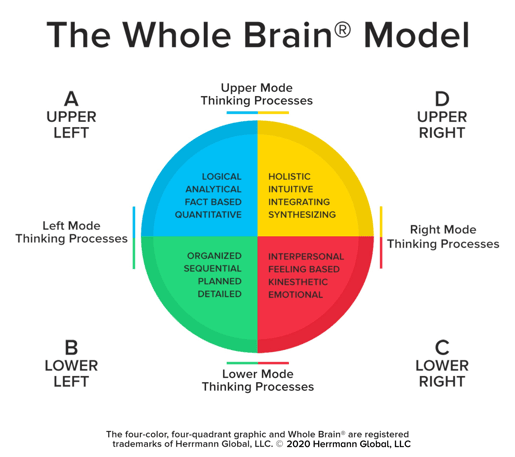As the virus has swept its way across the planet, people from all walks of life, families from every region, and businesses large and small have all had to adapt to change. The most common change, and the most likely one to be affecting you right now, is adjusting to any social distancing measures you're taking or a shelter-in-place mandate from your government, which has likely resulted in you staying at home. For many companies, it's also led to remote-working measures being set in place.
What happens when you are no longer sitting next to your teammates? What happens when going to work is simply walking to the next room? And more importantly, how do we separate our work and personal life while still being productive when both co-exist in the same space?
I've picked 5 of my favourite Whole Brain® Thinking techniques and how they can be applied to work-from-home and self-isolation situations so we can keep productivity up, whether in or outside of professional work hours.
Before we dive in, feel free to reference our Whole Brain® Model for context around the "quadrants" that will be referenced.

1. Create the perfect way to organize or build a to-do list using your thinking preferences.
As a strong D-Quadrant Thinker, my mother is a keen user of a noticeboard, and the amount of differently coloured sticky notes that she has on it right now suggests that she's pretty busy!
But what works for her, certainly doesn't work for a high A-Quadrant Thinker like me! Instead, I'm happier using an Excel spreadsheet to keep on track of tasks.
Someone with higher preference for B-Quadrant thinking may find more comfort in a notepad where they can bullet-point the tasks of the day, while C-Quadrant dominant Thinkers might focus on emails from colleagues or text prompts from their phone.
The point is, we now have an opportunity where you run your own office at home, and a huge advantage of that is tasks can be displayed and delivered exactly how you like it based on your knowledge of your own thinking preferences!
2. Start your day with tasks that suit your lowest thinking preference.
Is your lowest thinking preference for the C-Quadrant? Then schedule those longer meetings or phone calls for the morning, or whatever time your energy is at its highest.
Stretching into the B-Quadrant first thing after your coffee by creating a clean and tidy environment work space or by reviewing your calendar and to-do list for the day can also be beneficial. Why is this so important? It can be a huge mental boost to go through the day without feeling stress or dread when something comes up unexpectedly that you didn’t have time to prepare for.
Whatever your thinking preferences, it can be helpful for you to base your schedule for the day around those to maximize your energy levels and focus.
Sign up to our newsletter for the latest insights
I promise you, there will be times where it gets to afternoon and all those less preferable tasks turn into 'Ugh, I will just do it tomorrow' tasks, so I say bite the bullet and enjoy the relief when you’ve gotten it over and done with early on in your day and you have the rest of your day to do much more interesting work that caters to your thinking style.
3. Use your Whole Brain® Thinking awareness to collaborate with family or others you live with at home.
Our new 'colleagues' are now our family and children (or any other flatmates you might have), so it's fair to say that our work atmosphere can certainly be different than when we only had to deal with our cubicle neighbors!
Understanding what a partner's thinking preferences may be could go a long way to keeping the peace and working on those home projects at a much higher standard.
For example, you may know that a day in the garage sorting out and organizing is your partner's idea of a day in hell. However, with awareness (or at least a strong guesstimate) that they have a primary thinking preference for the C-Quadrant perhaps having that all-important call with the estate agent is a task better suited for them, while if you have a higher preference for the more organized and practical B-Quadrant, you might take up tidying the garage. My own partner and I have leveraged knowledge of our HBDI® results to help us be more efficient about dividing chores and tasks at home by aligning the process with our thinking preferences.
4. Your profile may suggest the perfect new hobby.
More time required to stay at home will undoubtedly cause more boredom or complacency for some of us, so we'll need to look for ways to break from the norm and keep ourselves agile.
I was chatting to a friend over the weekend who had used self-isolation to not only find a new hobby, but to create a completely new career path, and it was pretty inspiring.
With a primary thinking preference in the D-Quadrant and a keen interest in Art, they took this isolation as an opportunity to put foundations in place to create a new business applying their artwork to useful objects to sell online, a dream job made a reality.
I'm not suggesting we should jack our jobs in and begin a new life, but I think there is some value in using this time wisely to explore ourselves and discover something new.
Digital learning, hobbies and interests can really flourish and my understanding of my strong A-Quadrant thinking preference has prompted me to complete a course in Excel and get involved with data analysis and interpretation. What will you do?
5. Embrace/Stretch into the RED.
Okay, so I'm leaving the most important one till last. We can't just turn to the person next to us when we have a question anymore, nor can we make the quick trip to the next bank of desks to talk to the manager for directions.
We are in a situation now where picking up the phone, sending that email and communicating continually through the day are major factors in keeping us productive and on the right track.
Meetings are a necessity and a major source of information, but they’re also an opportunity for personal connection with our teammates.
They are also a chance for us to be mindful of how our thinking preferences and those of others interplay. How can you stretch to make your meetings Whole Brained?
For example, high C-Quadrant and D-Quadrant Thinkers – a new challenge has arrived. There is a sudden need to summarize during each meeting and keep the content clear, factual and to a structure to take into consideration the needs of the predominantly left mode, A-Quadrant and B-Quadrant Thinkers in attendance.
But the stretch into the RED doesn't stop there!
Use social media, text your friends, call your family that are isolated elsewhere.
Understand that just because you're coping perfectly fine at home on your own, others you hold dear or that you work with may be really struggling and that one phone call, a personal note, or quick text could totally make their day.
Now's the time to stretch into the RED.
Whole Brain® Thinking can be applied to so many situations, for anyone anywhere. It's an incredible tool to have at your disposal in a work or home environment, but it's also going to give you an understanding of others and their cognitive diversity so that you can communicate with them in a meaningful way and speak to their preference. This is an opportune time to learn the Whole Brain® Thinking model and what it can unlock in terms of improving service and communicating with new purpose and understanding.
This post was a contribution from one of the Herrmann team, Shaun Botham, Client Support UK/EMEA.
For more tips from our company about working from home, download the e-book, "Going Remote: A Whole Brain® Guide For Remote Management & Distributed Productivity."












